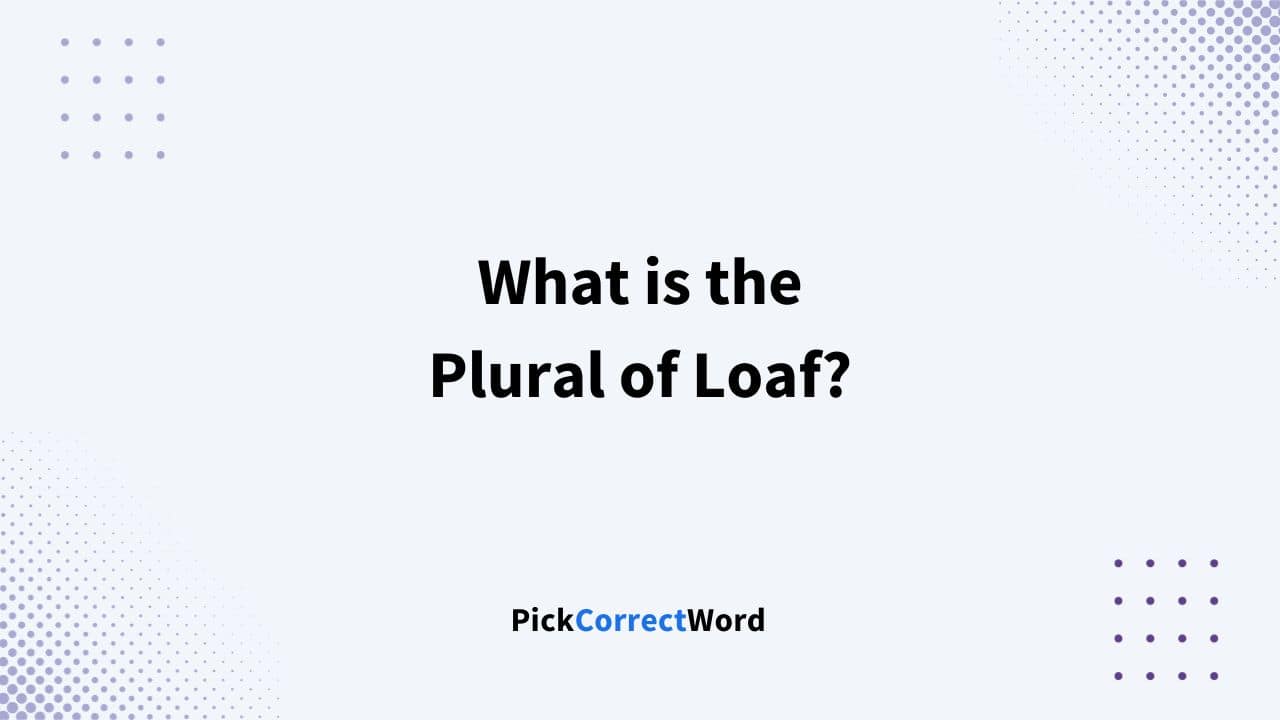When you hear the word loaf, you might be unsure about how to talk about many of them.
If you’ve got more than one loaf, the correct word to use is loaves.
This can seem a bit tricky because not all English words follow the same rule when we’re talking about more than one thing.
Knowing this can come in handy, especially if you’re buying or baking bread. Imagine asking for ‘two loafs’ at a shop – you may get a strange look because the proper way to say it is ‘two loaves’.
What is the Plural of Loaf in English?
The plural of loaf is loaves.
This change from ‘f’ to ‘ves’ in the plural form is part of English grammar rules for certain words.
For example:
- Singular: “Here is a freshly baked loaf for you.”
- Plural: “I need three loaves of bread for tonights family dinner.”
Remember, if you’re talking about just one, it’s a loaf, but for more than one, you should always say loaves.
Plural of words ending in ‘f’ or ‘fe’
The unique plural form of the word loaf is due to a specific rule about plural forms in the English language.
When you form the plural of words that end in ‘f’ or ‘fe’, you often change the ‘f’ to a ‘v’ and add ‘es’.
For example:
- ‘knife’ becomes ‘knives’
- ‘life’ becomes ‘lives’.
This pattern applies to the word ‘loaf’, resulting in the plural ‘loaves’.
For example: “I bought two loaves of bread.”
What about the variants of loaf?
It is also important to remember that the word ‘loaf’ can refer to different types, such as a ‘meatloaf’ or a ‘loaf of bread’.
No matter the variant, the plural form remains ‘loaves’.
For example: “She made several meatloaves for the dinner party.”
Bread Types and Their Plurals
When you come across different types of bread, you may wonder how to correctly use their plural forms.
Here’s a list of common bread types that you might encounter:
- White Bread
- Wholemeal Bread
- Rye Bread
- Sourdough
Plurals for Different Breads
The plural forms of bread types can be straightforward for some, but others follow less common patterns. Some of these types don’t need to be referred to as “loaves of”. You can simply use the name of the bread and make that word plural directly.
See the below details:
- White, Wholemeal, and Rye – When referring to these breads in the plural form, simply add an “s”. For example, if you bought more than one loaf of white bread, you would say, “I purchased two whites.”
- Sourdough and Manchet – These types of bread use the regular singular and plural forms where you would add “s” for the plural. So, “three sourdoughs” or “several manchets” would be correct.
By remembering these details, you can confidently talk about multiple types of bread without hesitation.
Examples of Using the Singular of Loaf in A Sentence
“You need to buy a loaf of bread.“
“Slice the loaf thinly for sandwiches.”
“There’s one loaf left in the pantry.”
“Could you bake a loaf for dinner?”
“She wrapped the loaf in foil.”
Examples of Using the Plural of Loaf in A Sentence
“You need to buy two loaves of bread for dinner.”
“Carefully place the loaves in the oven.”
“During the feast, you passed around several loaves.”
“Please remember to slice the loaves before serving.”
“When shopping, remember that loaves are on sale.”
Plural of Loaf: UK vs US english
You might be curious if there’s a difference in making words like ‘loaf’ plural in UK English compared to US English.
Let’s clarify this: there’s no difference in how you make ‘loaf’ plural in UK and US English.
In both versions, you make ‘loaf’ plural by changing the ending ‘f’ to ‘ves’. So, one loaf turns into many loaves in both UK and US English.
This rule is the same for other similar words as well, where both UK and US English agree that words ending in ‘f’ or ‘fe’ usually become plural by replacing these endings with ‘ves’.
Here are some quick examples for your reference:
- Half → Halves
- Knife → Knives
- Wife → Wives
Remember, whether you’re ordering at a bakery in London or Los Angeles, you’ll ask for “two loaves of bread” and be understood perfectly.
Frequently Asked Questions
What is the rule for pluralizing words that end with ‘f’?
For most nouns ending in ‘f’ or ‘fe’, you change the ‘f’ to a ‘v’ and add ‘es’ to form the plural. For instance, ‘knife’ becomes ‘knives’, and ‘wife’ becomes ‘wives’.
When do you use ‘loaves’ as the plural form?
You use ‘loaves’ as the plural form of ‘loaf’. This is an example of an irregular noun where the ‘-f’ ending is replaced with ‘-ves’ in the plural form.
Are there any exceptions to the general pluralization rule for nouns ending in ‘f’ or ‘fe’?
Yes, there are exceptions. While many words ending in ‘f’ or ‘fe’ follow the ‘ves’ rule, some simply add an ‘s’. For example, ‘roof’ becomes ‘roofs’, not ‘rooves’.


